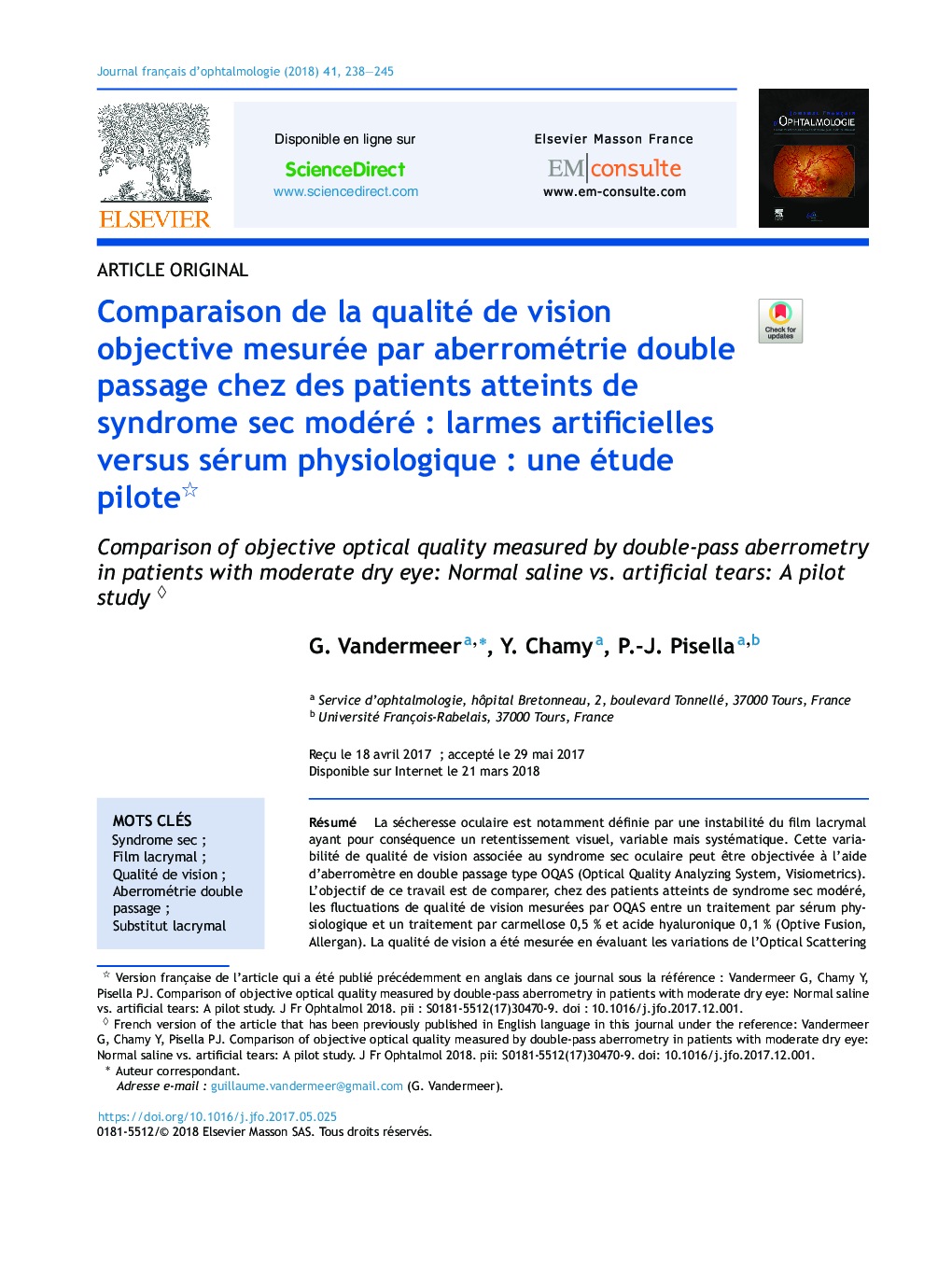| کد مقاله | کد نشریه | سال انتشار | مقاله انگلیسی | نسخه تمام متن |
|---|---|---|---|---|
| 8793499 | 1602763 | 2018 | 8 صفحه PDF | دانلود رایگان |
عنوان انگلیسی مقاله ISI
Comparaison de la qualité de vision objective mesurée par aberrométrie double passage chez des patients atteints de syndrome sec modéré : larmes artificielles versus sérum physiologique : une étude pilote
دانلود مقاله + سفارش ترجمه
دانلود مقاله ISI انگلیسی
رایگان برای ایرانیان
کلمات کلیدی
موضوعات مرتبط
علوم پزشکی و سلامت
پزشکی و دندانپزشکی
چشم پزشکی
پیش نمایش صفحه اول مقاله

چکیده انگلیسی
Dry eye is defined by a tear film instability resulting in variable but systematic fluctuations in the quality of vision. Variability in optical quality can be demonstrated using a double pass aberrometer such as the OQAS (Optical Quality Analyzing System, Visiometrics). The goal of this work is to compare fluctuations in objective quality of vision measured by OQAS between treatment with normal saline eye drops and treatment with carmellose 0.5% and hyaluronic acid 0.1% (Optive Fusion [OF], Allergan) in patients with moderate dry eye syndrome. Optical quality was measured by evaluating the variations in the Optical Scattering Index (OSI) over 20 seconds using the OQAS. Inclusion criteria were dry eye syndrome with an Ocular Surface Disease Index (OSDI) score > 23 treated only with artificial tears. The patients were their own controls: OF in one eye and normal saline in the fellow eye. The choice of the subject eye and control eye was determined in a randomized fashion. OSI variations were measured in each eye before instillation, 5 minutes and 2 hours after instillation. The primary endpoint was OSI fluctuation over 20 seconds of measurement. Secondary endpoints were the number of blinks and patient's preference (preferred eye). Preliminary results were obtained on 19 patients. Average OSDI score was 36.8. Visual acuity was 10/10 with no significant difference between the two eyes. Prior to instillation, there was no significant difference between “normal saline” and “OF” eyes in terms of OSI, OSI variability or number of blinks. In the normal saline eye, there was no significant variation in mean OSI, OSI variability, OSI slope, or number of blinks. However, in the “OF” eye, there was a significant variation between initial and 2-hour OSI variability (0.363 versus 0.204; P < 0.05), the average slope of OSI (0.04 versus 0.01; P < 0.05) and the number of blinks (4.2 versus 2.8; P < 0.05). Sixty-five percent of patients preferred the OF eye, 24% did not have a preference, and 11% preferred the normal saline eye. Objective quality of vision measured by OQAS is an interesting parameter for evaluating the effectiveness of a lacrimal substitute. The purpose of artificial tears is, among other things, to provide comfort and a reduction of dry eye symptoms such as poor quality of vision. This study demonstrates that 0.5% carmellose and 0.1% hyaluronic acid allowed better stabilization of the tear film and thus a significant improvement in the quality of vision compared to normal saline.
ناشر
Database: Elsevier - ScienceDirect (ساینس دایرکت)
Journal: Journal Français d'Ophtalmologie - Volume 41, Issue 3, March 2018, Pages 238-245
Journal: Journal Français d'Ophtalmologie - Volume 41, Issue 3, March 2018, Pages 238-245
نویسندگان
G. Vandermeer, Y. Chamy, P.-J. Pisella,